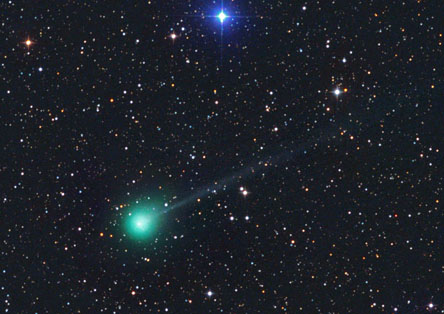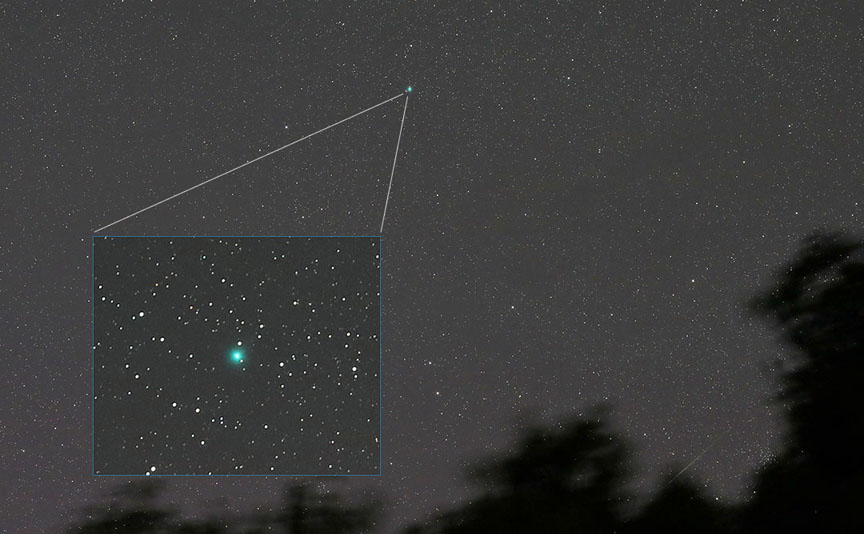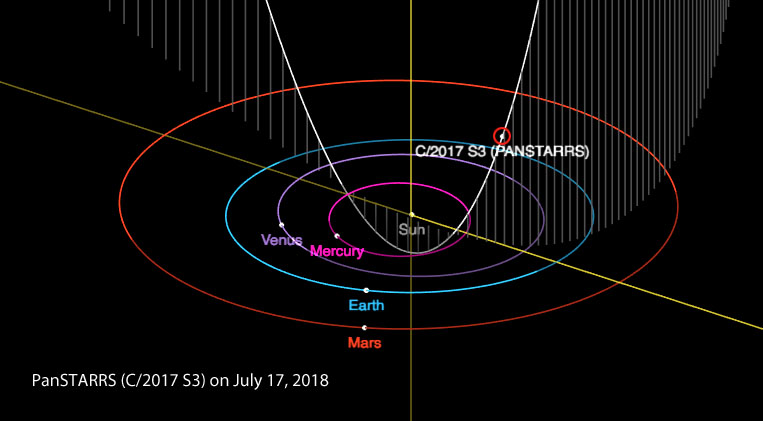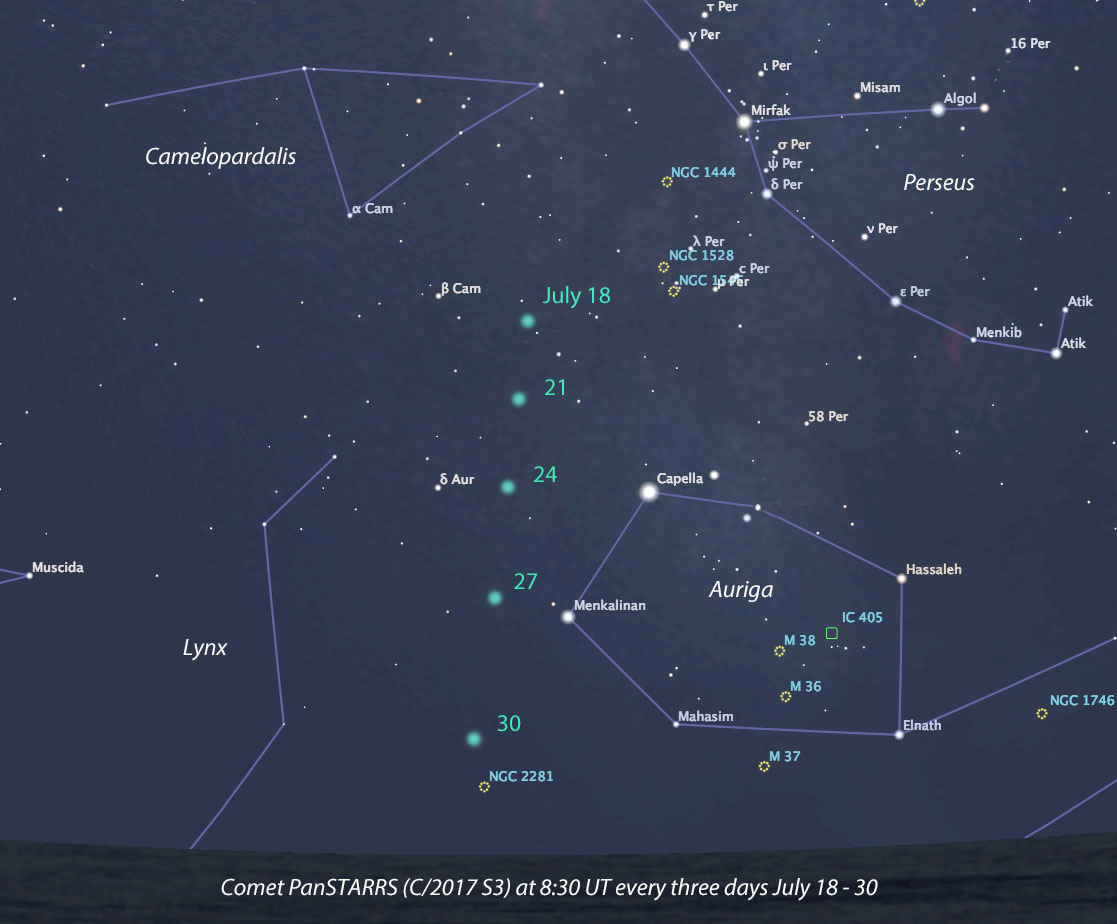Comet PanSTARRS (C/2017 S3) has erupted again! Now bright enough to see in binoculars, it might become a naked-eye object if it survives until perihelion.

Michael Jäger
You gotta love comets. OK, except when they fizzle. But outside of that, they can be tremendous fun to watch. That's so true of Comet PanSTARRS (C/2017 S3), which is now undergoing a second outburst just two weeks after its first. This latest explosion has pumped enough life into the vagabond to see it in a pair of binoculars. No kidding. I spotted with ease in my 10×50s on July 16.20 UT. Nothing fancy, just a small blob, but at magnitude ~8.2 it was obvious.
With a Frankensteinian jolt, C/2017 S3 first came to life on or about June 30th, sitting straight up at magnitude 9.5 after a three magnitude outburst. The explosion released a significant amount of C2 or diatomic carbon gas, which gives comet comas their characteristic aqua-green hue. Swan Band filters capitalize on this fact by transmitting only a few narrow slivers of light, including C2 emissions, to provide clearer and contrastier views of "gassy" comets.
Days later, C/2017 S3's core began to fade as the explosion played itself out. But just when we suspected the comet had hit the self-destruct button — as some predicted it would and still might — it burst back to life on or about July 14th, bigger and brighter than before. Austrian comet observer and astrophotographer Michael Jäger may have been first to record the new blast. His photo, taken July 1.04 UT, shows a gorgeous green coma 4′ in diameter trailed by a narrow, 25′-long ion tail to the northwest.

Bob King
In my 15-inch (37-cm) telescope on July 16th and 17th, the blue-green coma color was obvious at 64× magnification. Without the Swan filter I estimated the coma diameter at 3′ with a DC (degree of condensation) of 6, i.e., strongly condensed. With the filter in place the comet's head expanded to 4′. No tail was seen despite dark Bortle Class 3 skies.
C/2017 S3 could brighten to magnitude 3 or 4 as it beelines from Camelopardalis into Gemini now through about August 8th, when morning twilight gets in the way. Perihelion occurs on August 15th with the comet only 0.2 a.u. from the Sun. Closest approach to Earth happens a week earlier on August 7th at 0.76 a.u. Since the comet is fresh from the Oort Cloud, it's a bit of an unknown. It may explode again and cash in its chips before perihelion or power through. We'll know very soon. (Update July 20: C/2017 S3 continues to brighten, currently at magnitude 7. Update July 22: Comet has suddenly faded to magnitude ~9.5 and lost its narrow tail.)

JPL / HORIZONS
Because of its northerly declination (currently +55°N), C/2017 S3 is visible all night long for the northern third of the U.S. and Europe. You can look for it low in the northern sky at nightfall; by the start of dawn, it's ~30° high in the northeast. For the southern third of the U.S., it's at or below the northern horizon at nightfall and best seen just before dawn about 30° up in the northeastern sky. This green phantom is slipping south and will slowly lose altitude over the next few weeks. Take a look soon because, well, it's a comet, and you just never know.

Stellarium
Another fuzzball, 21P/Giacobini-Zinner, is fattening up nicely. Now at magnitude ~10, I caught it crawling past Delta (δ) Cephei on the night of July 15–16. It was still small with a 2′ coma and short 4′ tail pointing southwest, but the coma was bright and dense with a false nucleus — not only pretty but a good omen for continued brightening. According to predictions, 21P/G-Z will peak around magnitude 7 in August and September. For the moment, an 8-inch should give a good view, but it won't be long before small scopes scoop it up.
Easy comets like these make it a little easier to tolerate the pesky mosquitoes that descend this time of year. To find our targets, use this chart for 21P/Giacobini-Zinner. It plots stars to magnitude 9.5 with positions marked at 0h UT every three days. For Comet PanSTARRS (C/2017 S3) use the one above or try this more detailed map. You can also visit The Sky Live where current comets' daily positions are plotted on a photographic sky.
 13
13









Comments
Bob
July 17, 2018 at 11:29 pm
Interesting article on Comet PanSTARRS (C/2017 S3).
You must be logged in to post a comment.
Joe Stieber
July 18, 2018 at 4:13 am
This morning, 18-July-2018, I was out front of my suburban home in Maple Shade, NJ, to see if I could spot C/2017 S3 (PANSTARRS) with 15x56 binoculars. The sky wasn’t too good with passing cirrus clouds, but I had no trouble finding my reference stars, 4 & 5 Cam, through fleeting cloud gaps. With patience, when I had a relatively clear patch around 3:30 am EDT, I could just barely see a fuzzy “star” in roughly the correct spot as shown with SkySafari on my smart phone. But I didn’t have my reading glasses, so I couldn’t confirm it until I stepped back inside, made a diagram, then compared it to a SkyTools chart. In particular, it looked paired with a faint star in the binoculars, and when checked with SkyTools, S3 was 12 arc minutes from the magnitude 7.9 star, HD 30518 (remember, I was under a semi-cloudy suburban sky, and it was quite humid after rain the previous evening). I can’t wait until tomorrow. The forecast looks good so I’ll head to the darker NJ Pines for a better view.
You must be logged in to post a comment.
Tom-Reiland
July 18, 2018 at 4:13 am
Bob, I just viewed PanSTARRS S3 from my light polluted backyard through my 10 X 50 binoculars. It took me a while to lock onto the region in Camelopardalis and eliminate any false impressions due to poor seeing low in the NNE. I could not see any color, just a small, fuzzy object. It was between 4 and 5 Camel, though closer to 5 Camel. I observed Stock 23, NGC 1545 and several other clusters during my search. I hope to have a better view of it from Wagman Observatory tomorrow night. Thanks again for the info.
You must be logged in to post a comment.
Tom-Reiland
July 18, 2018 at 4:27 am
I forgot to mention its brightness, though I'm not certain of the magnitude of the comet I estimated it at between 7.5 and 8.0 mag. Under better conditions, I could make a finer estimate.
You must be logged in to post a comment.
Bob KingPost Author
July 18, 2018 at 6:32 pm
Joe and Tom,
Really appreciate your confirming observations. Looks like the comet outburst is still holding.
You must be logged in to post a comment.
Tom-Reiland
July 19, 2018 at 4:39 am
Bob, I was able to observe both comets Wednesday night from Wagman Observatory. Comet G-Z was definitely brighter than the last time I saw it about 10 nights ago. I put it at 9 mag, maybe slightly brighter. PanSTARRS (C/2017 S3) was similar to the previous night. I had no trouble finding it through my 10 X 50s and it showed a bright nucleus through the 21" Reflector with a faint star shining through the Coma near the nucleus. Thursday night might be to last chance to observe both comets in our area because of rain and storms heading our way and the Moon waxing towards Full.
You must be logged in to post a comment.
Joe Stieber
July 19, 2018 at 6:04 am
What a difference a day makes. On Thursday morning, 19-July-2018 around 3 am EDT, C/2017 S3 (PANSTARRS) was easy to see with my 15x56 binoculars under a clear sky in the relatively dark NJ Pines. In my 85 mm spotting scope at 60x, the coma had a bright central spot. I could not detect any color or a tail with either the binoculars or the scope.
You must be logged in to post a comment.
DustinRuoff
July 20, 2018 at 8:53 pm
I'm up in relatively dark Exeter NH, went out Wed 7/19 at 4:30AM EST because the position was to be high enough in the sky for me to see above concerning trees, but it was too close to dawn and thus too bright! I went out the next night Thu 7/20 at 3:30 AM and using SkySafari in night mode on my Macbook pro, I was able to find the location and then pop into dark with my new Celestron SkyMaster Giant 15x70s and within a few min was able to spot the comet! It was indeed just a fuzzy blob but pretty clearly in the spot noted by SkySafari. There was a helpful star formation that had a 3-star pyramid on the right side and a 4 star tail behind it, or perhaps a snake, but it was easy to find that formation and the comet right below it. I don't think I could have found this without the software for sure!
You must be logged in to post a comment.
Bob KingPost Author
July 22, 2018 at 12:10 am
Hi Dustin,
Thanks for writing and sharing your observation. A new outburst that started about July 17 brought the comet up to mag. 7 but it's now faded again to ~9. Lots of surprises with this one.
You must be logged in to post a comment.
DustinRuoff
July 20, 2018 at 8:55 pm
Whoops! I think I got the dates wrong. So the first non observation was Thurs 7/19 and the 2nd confirmed observation was Fri 7/20!
You must be logged in to post a comment.
SNH
July 24, 2018 at 5:25 pm
Nice article, Bob!
I had tried for C/2017 S3 shortly after you first reported its outburst and couldn't see it in morning twilight at 78x - so I assumed it had dimmed back some. But after seeing this article (possibly mag 7!), I tried again for it...this time in only 8x56 binoculars. So on the 22, 23, and 24 I got out and viewed it along with 21P G-Z. What I found (only in binos) was that on the first night, 21P G-Z was hard to see in the glare of a 7th magnitude star while S3 was easier. On the 23rd, 21P G-Z had moved away from the star and was just barely 7x35 bino visible while S3 was not quite as easy as I had found it on the 22nd. This morning (the 24th), I found both comets to be about magnitude +9.0 with S3 possibly closer to +8.5 (it was a little easier to see in 7x35 binos than 21P G-Z). I'll try and keep an eye on both of them because I want to catch them naked-eye if I can!!!
Scott
You must be logged in to post a comment.
Bob KingPost Author
July 25, 2018 at 10:13 am
Great observations, Scott! Nice to hear you saw both in 7x35s on the 24th. It appears that at least for now, C/2017 S3 has stabilized, ie. it's holding steady and staying together in one piece.
You must be logged in to post a comment.
wrightblades
July 25, 2018 at 8:04 am
I wonder if what an asteroid of this size would do to earth, i have many other questions, thats why i purchase simulators like this one here https://bit.ly/2Ogoxz3
You must be logged in to post a comment.
You must be logged in to post a comment.